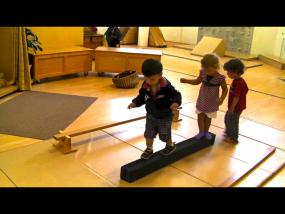Fixing One End Undoes the Other

Some problems require that the child realize that fixing one thing might at the same time undo something that was previously fixed. We saw this in “Leaving the Loop,” where the child eventually realized that using his left hand to take the glue off his right hand created a problem by having the glue now stuck to his left hand. How does the child adjust to the back and forth of creating a problem by solving a problem? In the case of “Leaving the Loop,” the child used his mouth to get the glue off his finger. In the video you are about to watch of Golden trying to support both the right and left ends of a long balance beam, Golden changes his goal. Instead of walking along a level beam elevated by two supports on each end, he allows one end to remain unsupported as he walks up the incline. After all, the rules of play are fluid. Play gives children the option of either solving or bypassing a problem with no loss of face. Indeed, the playful child finds joy in simplifying a task. We also see the reverse, where children complicate a game to make it more fun, as in “Why Children Make Play Challenging.” The choice to simplify or complicate arises from the child’s knowledge of his/her limits, limits imposed by the questions, “Do I think I can figure out why this is not working?” and “Do I want to lose play time by trying to make things work in just one particular way?”. While watching Golden, think about which of these questions might apply, or you may have another reason that explains why he decides not to make the balance beam level. There are other moments of note in this video. The light-weight beam (the dark one) has so little mass that a step not exactly centered on the long axis of the beam will cause the beam to tip. Such a beam provides an additional challenge that children can enjoy meeting. One of the girls seems particularly adept at placing her feet centered on this axis. Also notice how the children take an ordinary step off the end of the beam. The children jump up with excitement to accentuate that they have made it to the end, even when they reach the end of the two by four laying flat on the floor. Perhaps they realize that the challenge does not come from the distance of the beam from the floor, but rather from the narrowness of the beam itself. Therefore, successfully walking the length of a long two by four flat on the floor merits the same excitement as walking the length of that same beam held aloft six inches off the floor. Length of Video Clip: 4 minutes 1 second Keywords: Threes, Body, Balance, Problem Solving, Cooperation
